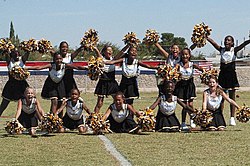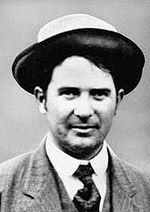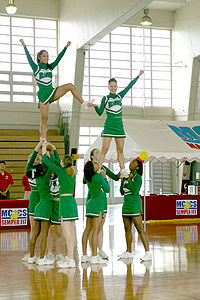Cheerleading: Difference between revisions
| Line 58: | Line 58: | ||
*[[Hilarie Burton]] |
*[[Hilarie Burton]] |
||
*[[Miley Cyrus]]<ref name="famous">{{cite web | title=Famous Cheerleaders | url=http://cheerleading.about.com/od/famouscheerleaders/Famous_Cheerleaders.htm | accessdate=2007-06-11}}</ref> <ref>http://highschool.rivals.com/photofeature.asp?SID=1185&fid=20578</ref> |
*[[Miley Cyrus]]<ref name="famous">{{cite web | title=Famous Cheerleaders | url=http://cheerleading.about.com/od/famouscheerleaders/Famous_Cheerleaders.htm | accessdate=2007-06-11}}</ref> <ref>http://highschool.rivals.com/photofeature.asp?SID=1185&fid=20578</ref> |
||
*[[Britney Spears]] and [[Jamie Lynn Spears]] |
*[[Britney Spears]]CRAZY and [[Jamie Lynn Spears]]PREGNANT |
||
==Cheerleading in popular culture== |
==Cheerleading in popular culture== |
||
Revision as of 16:45, 22 May 2008
The examples and perspective in this article may not represent a worldwide view of the subject. |

Cheerleading is a sport[1][2][3][4] that uses organized routines made from elements of some tumbling, dance, jumps and stunting to direct the event's spectators to cheer on sports teams at games and matches and/or compete at cheerleading competitions. The athlete involved is called a cheerleader. With an estimated 1.5 million participants in allstar cheerleading (not including the millions more in high school, college or little league participants) in the United States alone, cheerleading is, according to Newsweek's Arian Campo-Flores, "the most quintessential of American sports."[1] The growing presentation of the sport to a global audience has been led by the 1997 start of broadcasts of cheerleading competition by ESPN International and the worldwide release of the 2000 film Bring it On. Due in part to this recent exposure, there are now an estimated 100,000 participants scattered around the rest of the world in countries including Australia, China, Colombia, France, Germany, Japan,[5] the Netherlands, New Zealand and the United Kingdom. [1]
History

Cheerleading first appeared in the United States in the late 1880s with the crowd chanting as a way to encourage school spirit at athletic events. The first organized, recorded cheer was yelled "Ray, Ray, Ray! TIGER, TIGER, SIS, SIS, SIS! BOOM, BOOM, BOOM! Aaaaah! PRINCETON, PRINCETON, PRINCETON!" at Princeton University in 1884.[6] A few years later, Princeton graduate, Thomas Peebles introduced the idea of organized crowd cheering at football games to the University of Minnesota. However, it was not until 1898 that University of Minnesota student Johnny Campbell directed a crowd in cheering "Rah, Rah, Rah! Sku-u-mar, Hoo-Rah! Hoo-Rah! Varsity! Varsity! Varsity, Minn-e-So-Tah!”, making Campbell the very first cheerleader and November 2, 1898 the official birth date of organized cheerleading. Soon after, the University of Minnesota organized a "yell leader" squad of 6 male students, who still use Campbell's original cheer today[6] In 1903 the first cheerleading fraternity, Gamma Sigma was founded.[7] Cheerleading started out as an all-male activity, but females began participating in 1923, due to limited availability of female collegiate sports. At this time, gymnastics, tumbling, and megaphones were incorporated into popular cheers.[7] Today it is estimated that 97% of cheerleading participants are female, but males still makeup 50% of collegiate cheering squads. [8]

In 1948, Lawrence "Herkie" Herkimer, of Dallas, TX and a former cheerleader at Southern Methodist University formed the National Cheerleaders Association (NCA) as a way to hold cheerleading clinics. In 1949, The NCA held its first clinic in Huntsville, TX with 52 girls in attendance.[8] "Herkie" contributed many "firsts" to the sport including the founding of Cheerleader & Danz Team uniform supply company, inventing the herkie, (where one leg is bent towards the ground and the other is out to the side as high as it will stretch in the toe touch position)[9] and creating the "Spirit Stick".[7] By the 1960s, college cheerleaders began hosting workshops across the nation, teaching fundamental cheer skills to eager high school age girls. In 1965, Fred Gastoff invented the vinyl pom-pon and it was introduced into competitions by the International Cheerleading Foundation (now the World Cheerleading Association or WCA). Organized cheerleading competitions began to pop up with the first ranking of the "Top Ten College Cheerleading Squads" and "Cheerleader All America" awards given out by the International Cheerleading Foundation in 1967. In 1978, America was introduced to competitive cheerleading by the first broadcast of Collegiate Cheerleading Championships on CBS[6][7]
In the 1960's National Football League (NFL) teams began to organize professional cheerleading teams. The Baltimore Colts (now the Indianapolis Colts) was the first NFL team to have an organized cheerleading squad.[10] It was the Dallas Cowboys Cheerleaders who gained the spotlight with their revealing outfits and sophisticated dance moves, which debuted in the 1972-1973 season, but were first seen widely in Super Bowl X (1976). This caused the image of cheerleaders to permanently change, with many other NFL teams emulating them. Most of the professional teams' cheerleading squads would more accurately be described as dance teams by today's standards; as they rarely, if ever, actively encourage crowd noise or perform modern cheerleading moves.

The 1980s saw the onset of modern cheerleading with more difficult stunt sequences and gymnastics being incorporated into routines. ESPN first broadcasted the National High School Cheerleading Competition nationwide in 1983. Cheerleading organizations such as the American Association of Cheerleading Coaches and Advisors (AACCA) started applying universal safety standards to decrease the number of injuries and prevent dangerous stunts, pyramids and tumbling passes from being included in routines. [11] In 2003, the National Council for Spirit Safety and Education (NCSSE) was formed to offer safety training for youth, school, all star and college coaches. The NCAA requires college cheer coaches to successfully complete a nationally recognized safety-training program. The NCSSE or AACCA certification programs are both recognized by the NCAA.
Today, cheerleading is most closely associated with American football and basketball. Sports such as soccer, ice hockey, volleyball, baseball, and wrestling sometimes sponsor cheerleading squads. The ICC Twenty20 Cricket World Cup in South Africa in 2007 was the first international cricket event to have cheerleaders. The Florida Marlins were the first Major League Baseball team to have cheerleaders. Debuting in 2003, the "Marlin Mermaids" gained national exposure and have influenced other MLB teams to develop their own cheer/dance squads.
Types of teams
School-sponsored

Most American high schools and colleges have organized cheerleading squads made up solely of students. Several colleges that compete at cheerleading competitions offer cheerleading scholarships. Some military academies use their drill team or color guard team instead of a cheersquad at athletic events, but some military academies have traditional cheerleading squads just like other everyday universities.
Youth league
Many organisations that sponsor youth league football or basketball sponsor cheerleading squads as well. Pop Warner organizations are an example of this.
All-Star cheerleading
In the early 1980s, cheerleading squads not associated with a schools or sports leagues, whose main objective was competition, began to emerge. The first organization to call themselves all stars and go to competitions were the Q94 Rockers from Richmond, Virginia, founded in 1982 by Hilda McDaniel.[12] All-star teams competing prior to 1987 were place into the same divisions as teams that represented schools and sports leagues. In 1986 National Cheerleaders Association (NCA) decided to address this situation by creating a separate division for these teams lacking a sponsoring school or athletic association, calling it the 'All-Star Division' and debuting it at their 1987 competitions. As the popularity of these types of teams grew, more and more of them were formed, attending competitions sponsored by many different types of organizations and companies, all using their own set of rules, regulations and divisions. This situation became one of the chief concerns of gym owners. These inconsistencies caused coaches to keep their routines in a constant state of flux, detracting from time that should be utilized to develop skills and provide personal attention to their athletes. More importantly, because the various companies were constantly vying for the competitive edge, safety standards had becoming more and more lax. In some cases, unqualified coaches and inexperienced squads are attempting dangerous stunts as a result of these “expanded” sets of rules.[13]
The USASF was formed in 2003 by these various competition companies to act as the national governing body for all star cheerleading and to create a standard set of rules and judging standards to be followed by all competitions sanctioned by the Federation and ultimately leading to the Cheerleading Worlds. The USASF hosted the first Cheerleading Worlds on Saturday, April 24, 2004.[13] At the same time, cheerleading coaches from all over the country organize themselves for the same rule making purpose, calling themselves the National All Star Cheerleading Coaches Congress (NACCC). In 2005, the NACCC was absorbed by the USASF to become their rule making body.[12] By late 2006, the USASF was ready to expand its reach even further, by facilitating the creation of the International All-Star Federation (IASF), the first international governing body for the sport of cheerleading. [14]
Currently all-star cheerleading as sanctioned by the USASF involves a squad of 6-36 females and/or males. The squad prepares year-round for many different competition appearances, but they only actually perform for up to 2½ minutes during their routines. The numbers of competitions a team participates in varies from team to team, but generally, most teams tend to participate in eight-ten competitions a year. During a competition routine, a squad performs carefully choreographed stunting, tumbling, jumping and dancing to their own custom music. Teams create their routines to an eight-count system and apply that to the music so the team members execute the elements with precise timing and synchronization.
Judges at the competition watch for illegal moves from the group or any individual member. Here, an illegal move is something that is not allowed in that division due to difficulty and safety restrictions. More generally, judges look at the difficulty and execution of jumps, stunts and tumbling, synchronization, creativity, the sharpness of the motions, showmanship, and overall routine execution.
All-star cheerleaders are placed into divisions, which are grouped based upon age, size of the team, gender of participants, and ability level. The age levels vary from under 4 year of age to 18 years and over. The divisions used by the USASF/IASF are currently Tiny, Mini, Youth, Junior, Junior International, Junior Coed,Senior, Senior coed, Open International and Open.[15]
If a team places high enough at selected USASF/IASF sanctioned national competitions, they could be included in the Cheerleading Worlds and compete against teams from all over the world. Also they could get money for placing.[1]
Cheerleaders
Famous ex-cheerleaders
Many prominent people have been cheerleaders, including:
- Madonna
- Paula Abdul
- Ronald Reagan
- Franklin D. Roosevelt
- Dwight D. Eisenhower
- George W. BushFAGGOT[16]
- Meryl Streep
- Steve Martin
- Halle Berry
- Teri Hatcher
- Sandra Bullock
- Cameron Diaz
- Reese Witherspoon
- Hilarie Burton
- Miley Cyrus[17] [18]
- Britney SpearsCRAZY and Jamie Lynn SpearsPREGNANT
Cheerleading in popular culture
This section needs additional citations for verification. (September 2007) |
Cheerleading has increasingly become a larger influence in the media today. The individual cheerleader is an instantly recognized figure representing youthful attractiveness, leadership, and popularity.
Cheerleading is a staple in American culture. Cheerleading coincides with many other issues related to mass media: constantly changing style, and meanings, values, and symbolism associated within American culture. Mary Ellen Hanson in her book Go! Fight! Win!: Cheerleading in American Culture, said that cheerleader images are abounding in editorial, advertising, promotional, didactic, and entertainment media.
Movies and television
Also see List of cheerleaders in fiction
Cheerleading's increasing popularity in recent decades has made it a prominent feature in high-school themed movies and television shows. The 2000 film Bring It On, about a San Diego high school cheerleading squad called "The Toros", starring real-life former cheerleader Kirsten Dunst. Bring It On was a surprise hit and earned nearly $70 million domestically. It spawned two direct-to-video sequels (Bring It On Again in 2003 and Bring It On: All or Nothing in 2006). The fourth film in the franchise, Bring It On: In It to Win It, was released on December 18, 2007. Bring It On was followed in 2001 by another teen cheerleading comedy, Sugar & Spice. In 1993, The Positively True Adventures of the Alleged Texas Cheerleader-Murdering Mom was an acclaimed TV movie which told the true story of Wanda Holloway, the Texas mother whose obsession with her daughter's cheerleading career made headline news.
In 2006, Hayden Panettiere, star of Bring It On: All or Nothing, took another cheerleading role as Claire Bennet, the cheerleader with an accelarated healing factor on NBC's hit sci-fi TV series Heroes, launching cheerleading back into the limelight of pop culture. Claire was the main focus of the show's first story arc, featuring the popular catchphrase, "Save the cheerleader, save the world." Claire demonstrates a sensitive and caring persona atypical of the archetypal cheerleader. Her prominent, protagonist role in Heroes was supported by a strong fan-base and provided a positive image for high school cheerleading.
Video games
Nintendo has released a pair of video games in Japan for the Nintendo DS, Osu! Tatakae! Ouendan and its sequel Moero! Nekketsu Rhythm Damashii that star teams of male cheer squads, or Ouendan that practice a form of cheerleading unique to Japanese culture. Each of the games' most difficult modes replaces the male characters with female cheer squads that dress in western cheerleading uniforms. The games task the cheer squads with assisting people in desperate need of help by cheering them on and giving them the motivation to succeed.
Sport debate
Cheerleading among others has had debate on whether or not it truly is a sport. Supporters consider Cheerleading as a whole as a sport citing the heavy use of athletic talents[citation needed] and difficult stunts, which involve high physical demands, while critics do not see it as deserving of that status since sport implies a competition among squads and not all squads compete along with subjectivity of competitions.[19][20]
Dangers of cheerleading
There have been injuries associated with cheerleading. One of the most notable in recent years was that of Kristi Yamaoka, a cheerleader at Southern Illinois University. On March 5 2006, she fell off of a human pyramid during a cheerleading performance at a basketball game between Southern Illinois University and Bradley University at the Scottrade Center (then known as the Savvis Center) in St. Louis. Yamaoka leaned backward and fell off the third tier of a pyramid. Her performance from the stretcher as she was carried off the court was nationwide news. She suffered a fractured thoracic vertebra[21], concussion, and bruised lung, and has since made a full recovery.
As a result of the fall, the Missouri Valley Conference banned tossing or launching of cheerleaders, and no pyramid could be higher than two levels during that conference's women's basketball tournament. Additionally, the American Association of Cheerleading Coaches and Administrators recommended banning basket tosses and high pyramids without mats. Though the group has no authority to prevent such routines, the NCAA requires cheerleading squads to conform to the group's requirements. The AACCA rules committee made the bans permanent on July 11 2006.[22]
See also
- Artificial noise
- List of cheerleaders
- List of cheerleading jumps
- List of cheerleading stunts
- National Football League cheerleading
- Ōendan, a style of Japanese cheerleading
- Pom-pon
- UAAP Cheerdance Competition
- Cheerleader Nation
References
- ^ a b c d Campo-Flores, Arian (2007-05-14). "A World of Cheer!". Newsweek. Retrieved 2007-05-17.
{{cite journal}}: Check date values in:|date=(help) - ^ Schoenberger, Chana R. (2006-11-16). "The Most Dangerous Sports". Forbes. Retrieved 2007-06-29.
{{cite journal}}: Check date values in:|date=(help) - ^ CBS/AP (2006-01-03). "Cheerleading Injuries Increasing". The Early Show. CBS Broadcasting Inc. Retrieved 2007-06-29.
{{cite news}}: Check date values in:|date=(help) - ^ "IASF home page". Retrieved 2007-06-29.
- ^ Japan Echo, Inc (2005-05-30). "Three Cheers for the Champions!". Web Japan. Retrieved 2007-09-22.
{{cite news}}: Check date values in:|date=(help); External link in|work= - ^ a b c Neil, Randy L.; Hart, Elaine (1986), The Official Cheerleader's Handbook (Revised Fireside Edition 1986 ed.), Simon & Schuster, ISBN 0-671-61210-7
- ^ a b c d Walker, Marisa (February 2005), "Cheer Milestones", American Cheerleader, 11 (1): 41–43, ISSN 1079-9885
{{citation}}: CS1 maint: date and year (link) - ^ a b Balthaser, Joel D. (2005-01-06). "Cheerleading – Oh How far it has come!". Pop Warner. Retrieved 2007-01-11.
{{cite web}}: Check date values in:|date=(help) - ^ "Cheerleading Jump Herkie". Retrieved 2007-08-06.
- ^ "Indianapolis Colts - www.football.com". Retrieved 2007-11-04.
- ^ "About the AACCA". Retrieved 2007-01-11.
- ^ a b Smith, Jennifer Renèe (February 2007), "The All-Star Chronicles", American Cheerleader, 13 (1): 40–42, ISSN 1079-9885
{{citation}}: CS1 maint: date and year (link) - ^ a b "The Cheerleading Worlds Administered by the USASF". Varsity Brands, Inc. Retrieved 2007-09-20.
- ^ "USASF Insider" (pdf). Retrieved 2007-09-15.
- ^ "USASF All-Star Cheer Divisions for 2007-2008" (pdf). Retrieved 2007-06-29.
- ^ CNN report with picture of future President Bush as a cheerleader
- ^ "Famous Cheerleaders". Retrieved 2007-06-11.
- ^ http://highschool.rivals.com/photofeature.asp?SID=1185&fid=20578
- ^ "Sport, not a sport: consider Dan the expert". The Stanford Daily. 2004-9-29. Retrieved 2007-12-15.
{{cite journal}}: Check date values in:|date=(help) - ^ "No, Cheerleading is not a Sport". SFU Cheer Resources. 2004-9-29. Retrieved 2007-12-15.
{{cite journal}}: Check date values in:|date=(help) - ^ "Cheerleader worried for team, not herself". Retrieved 2007-09-29.
- ^ "CHEERLEADING PROGRAMS GOING ALL-OUT FOR SAFETY". Retrieved 2006-12-19.
External links
- International Cheer Union - Building the 1st Cheerleading Olympic Structure (ICU)
- National Council for Spirit Safety and Education (NCSSE)
- American Association of Cheerleading Coaches and Advisors (AACCA)
- United States All-Star Federation (USASF)
- International All Star Federation (IASF)
- British Cheerleading Association (BCA)
- UK Cheerleading Association (UKCA)
- Cheer Ireland (CFI)
- Cheerleading 101: the Basics
